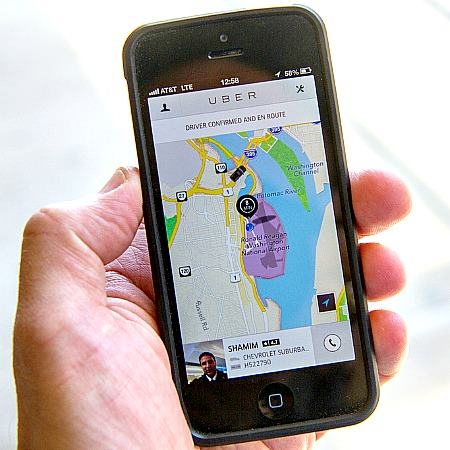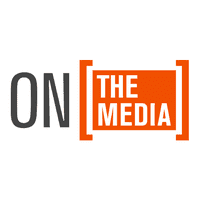The Customer Isn't Always Right

( flickr/Mike
)
Transcript
MANOUSH ZOMORODI: A few months ago, I joined Uber, the app-based car service that connects riders with available drivers in their area. On my very first day, I used the service for three different rides, and on the last ride I learned something upsetting. My driver told me that because I had such a low passenger rating, he almost didn't pick me up. That was a shock. Consumer ratings are at internet stable, but usually it's the consumer doing the rating. This two-way street isn’t really publicized by the company, so I decided to do some investigative passenging.
MANOUSH ZOMORODI: Do you want to say your name?
GANU SALAMI: My name is Ganu Salami.
MANOUSH ZOMORODI: Now, when this ride is over, I get to rate you, 1 to 5 stars, and then you get to rate me, right?
GANU SALAMI: We have to do good for each other.
MANOUSH ZOMORODI: You think it’s a great idea.
GANU SALAMI: Absolutely, it’s excellent good.
MANOUSH ZOMORODI: Tell me about when you rate your customers, what do you judge them on, what’s your criteria?
GANU SALAMI: Let’s say you get inside my car, you’re late already. You know you’re supposed to be at your job at 10 o’clock.
MANOUSH ZOMORODI: Uh-huh?
GANU SALAMI: And you get inside my car five minutes to 10. I mean, you know it’s not possible to get there in five minutes, and you get inside the car and you have an attitude, like, oh, it’s too much traffic, oh, you’re supposed to go this way, you’re supposed to go this way. Definitely I have to give you bad star.
MANOUSH ZOMORODI: So there’s a saying, I’m sure you’ve heard it, that the customer is always right. Do you think the customer is always right or does the new technology make things more equal?
GANU SALAMI: No, the customer is not always right, he’s not.
MANOUSH ZOMORODI: Looking back at my two Uber rides that could have led to my own bad rating, I can assume that it either came from the driver who didn't like me telling him that I was going to Clinton Avenue, not Clinton Street, thank you, or it was the driver who didn't like me wearing my headphones during the trip. Neither situation seemed like a punishable offense, to me.
But, according to University of Denver Law Professor Nancy Leong, there is the potential to get a bad rating for much less, just for being who you are. Leong says a big problem with the customer rating system in its potential to be discriminatory because, like all online bellyaching, the commenter needn’t face the commentee.
NANCY LEONG: The driver doesn’t have to look the passenger in the eye when the driver is giving the passenger a rating. If the driver sees a request for a pickup come in from a passenger who has uploaded a photo and the driver sees that the passenger is a racial minority, the fact that there is that electronic barrier again means that the driver doesn't have to look the passenger in the eye, the same way that a cab driver would, however briefly, have to look a black person in the eye if they choose to drive past them without picking them up.
MANOUSH ZOMORODI: I did an interview last year, when Uber first started here in New York, with an African-American woman who said she loved Uber and the reason why was explicitly because it solved, she thought, the prejudice problem. She said that taxis wouldn’t pick her up. Uber solved those problems.
NANCY LEONG: That is not inconsistent with racial minorities still potentially being treated worse than white people via the rating system that Uber uses. And so, while it may be that Uber makes it easier for minorities to get access to transportation, that doesn't necessarily mean that racial minorities are getting the same access to transportation.
MANOUSH ZOMORODI: So the Uber driver that I’d talked to about this, he seems to think that the customer rating system is a good idea, that it makes his job easier. He can avoid problem clients. Can’t this rating system be a good thing for weeding out the bad apples out there, or, or giving people an incentive to be better customers, to set a tone of civility?
NANCY LEONG: I absolutely think that there should be some mechanism for drivers to rate passengers, as well as passengers to rate drivers. Having said that, I think that there's a problem with transparency. The passenger doesn't know what her rating is, unless she can persuade a driver to tell her.
MANOUSH ZOMORODI: Or even that she is being rated.
NANCY LEONG: Or even that she is being rated, right. Like, this is not something that’s widely known because when you log in to your Uber account, there’s no rating there. Even if they know they’re being rated, they don't know why they get a good rating or a bad rating. If they don't know why they're getting poor ratings that really takes that incentive to be better passengers away or makes it less useful.
And what a lot of the social science research has shown is that implicit bias is most problematic when there aren’t guidelines, where there is just this unfettered discretion on the part of the person who's doing the evaluation.
MANOUSH ZOMORODI: So Nancy, you’re not the only one to express concern over Uber’s rating system. Earlier this month, the Florida Taxicab Association called the Uber rating practice “dangerous and discriminatory,” pointing out that it could have a negative impact on, for example, elderly riders who might need more assistance.
NANCY LEONG: Yeah.
MANOUSH ZOMORODI: The Florida Taxicab Association, obviously, they have an angle on this, that they don't want competition from Uber.
NANCY LEONG: Sure.
MANOUSH ZOMORODI: And then there’s me with my hurt feelings. But do you see any real legal implications for this customer rating system?
NANCY LEONG: There is a statute that was enacted after the Civil War in order to prevent discrimination by private parties, and what it essentially says is all citizens of the United States have the same right to make and enforce contracts as white citizens. Well, when a person contacts a company that offers the service of driving passengers from one place to another and indicates their desire to take advantage of that service, that’s a textbook example of an effort to make and enforce a contract. And if, due to the Uber rating system, it's easier for white people to form that contract than for people of other races, that sounds like a situation where people of other races are not being given the opportunity to make and enforce contracts, to the same degree as white citizens.
With respect to people with disabilities, the Americans With Disabilities Act reaches private companies as well, and if we were able to find that passengers with disabilities were rated worse and that the rating system over time led to people with disabilities waiting much longer for a car to come and pick them up, then I could see that potentially giving rise to a claim as well. All of these rating systems, while they certainly do have advantages, they also have ways in which people can manifest prejudices against various groups, whether they’re doing so on purpose or without knowing it.
MANOUSH ZOMORODI: Nancy Leong is a professor at the University of Denver, Sturm College of Law. Nancy, thanks so much for your time.
NANCY LEONG: Thank you too. It’s a pleasure to be here.
MANOUSH ZOMORODI: Uber declined our request for an interview. It did point us to a new blog entry that it posted just this week, which said, quote, “An Uber trip should be a good experience for drivers too. Drivers shouldn’t have to deal with aggressive, violent or disrespectful riders.”
MANOUSH ZOMORODI: A few months ago, I joined Uber, the app-based car service that connects riders with available drivers in their area. On my very first day, I used the service for three different rides, and on the last ride I learned something upsetting. My driver told me that because I had such a low passenger rating, he almost didn't pick me up. That was a shock. Consumer ratings are at internet stable, but usually it's the consumer doing the rating. This two-way street isn’t really publicized by the company, so I decided to do some investigative passenging.
MANOUSH ZOMORODI: Do you want to say your name?
GANU SALAMI: My name is Ganu Salami.
MANOUSH ZOMORODI: Now, when this ride is over, I get to rate you, 1 to 5 stars, and then you get to rate me, right?
GANU SALAMI: We have to do good for each other.
MANOUSH ZOMORODI: You think it’s a great idea.
GANU SALAMI: Absolutely, it’s excellent good.
MANOUSH ZOMORODI: Tell me about when you rate your customers, what do you judge them on, what’s your criteria?
GANU SALAMI: Let’s say you get inside my car, you’re late already. You know you’re supposed to be at your job at 10 o’clock.
MANOUSH ZOMORODI: Uh-huh?
GANU SALAMI: And you get inside my car five minutes to 10. I mean, you know it’s not possible to get there in five minutes, and you get inside the car and you have an attitude, like, oh, it’s too much traffic, oh, you’re supposed to go this way, you’re supposed to go this way. Definitely I have to give you bad star.
MANOUSH ZOMORODI: So there’s a saying, I’m sure you’ve heard it, that the customer is always right. Do you think the customer is always right or does the new technology make things more equal?
GANU SALAMI: No, the customer is not always right, he’s not.
MANOUSH ZOMORODI: Looking back at my two Uber rides that could have led to my own bad rating, I can assume that it either came from the driver who didn't like me telling him that I was going to Clinton Avenue, not Clinton Street, thank you, or it was the driver who didn't like me wearing my headphones during the trip. Neither situation seemed like a punishable offense, to me.
But, according to University of Denver Law Professor Nancy Leong, there is the potential to get a bad rating for much less, just for being who you are. Leong says a big problem with the customer rating system in its potential to be discriminatory because, like all online bellyaching, the commenter needn’t face the commentee.
NANCY LEONG: The driver doesn’t have to look the passenger in the eye when the driver is giving the passenger a rating. If the driver sees a request for a pickup come in from a passenger who has uploaded a photo and the driver sees that the passenger is a racial minority, the fact that there is that electronic barrier again means that the driver doesn't have to look the passenger in the eye, the same way that a cab driver would, however briefly, have to look a black person in the eye if they choose to drive past them without picking them up.
MANOUSH ZOMORODI: I did an interview last year, when Uber first started here in New York, with an African-American woman who said she loved Uber and the reason why was explicitly because it solved, she thought, the prejudice problem. She said that taxis wouldn’t pick her up. Uber solved those problems.
NANCY LEONG: That is not inconsistent with racial minorities still potentially being treated worse than white people via the rating system that Uber uses. And so, while it may be that Uber makes it easier for minorities to get access to transportation, that doesn't necessarily mean that racial minorities are getting the same access to transportation.
MANOUSH ZOMORODI: So the Uber driver that I’d talked to about this, he seems to think that the customer rating system is a good idea, that it makes his job easier. He can avoid problem clients. Can’t this rating system be a good thing for weeding out the bad apples out there, or, or giving people an incentive to be better customers, to set a tone of civility?
NANCY LEONG: I absolutely think that there should be some mechanism for drivers to rate passengers, as well as passengers to rate drivers. Having said that, I think that there's a problem with transparency. The passenger doesn't know what her rating is, unless she can persuade a driver to tell her.
MANOUSH ZOMORODI: Or even that she is being rated.
NANCY LEONG: Or even that she is being rated, right. Like, this is not something that’s widely known because when you log in to your Uber account, there’s no rating there. Even if they know they’re being rated, they don't know why they get a good rating or a bad rating. If they don't know why they're getting poor ratings that really takes that incentive to be better passengers away or makes it less useful.
And what a lot of the social science research has shown is that implicit bias is most problematic when there aren’t guidelines, where there is just this unfettered discretion on the part of the person who's doing the evaluation.
MANOUSH ZOMORODI: So Nancy, you’re not the only one to express concern over Uber’s rating system. Earlier this month, the Florida Taxicab Association called the Uber rating practice “dangerous and discriminatory,” pointing out that it could have a negative impact on, for example, elderly riders who might need more assistance.
NANCY LEONG: Yeah.
MANOUSH ZOMORODI: The Florida Taxicab Association, obviously, they have an angle on this, that they don't want competition from Uber.
NANCY LEONG: Sure.
MANOUSH ZOMORODI: And then there’s me with my hurt feelings. But do you see any real legal implications for this customer rating system?
NANCY LEONG: There is a statute that was enacted after the Civil War in order to prevent discrimination by private parties, and what it essentially says is all citizens of the United States have the same right to make and enforce contracts as white citizens. Well, when a person contacts a company that offers the service of driving passengers from one place to another and indicates their desire to take advantage of that service, that’s a textbook example of an effort to make and enforce a contract. And if, due to the Uber rating system, it's easier for white people to form that contract than for people of other races, that sounds like a situation where people of other races are not being given the opportunity to make and enforce contracts, to the same degree as white citizens.
With respect to people with disabilities, the Americans With Disabilities Act reaches private companies as well, and if we were able to find that passengers with disabilities were rated worse and that the rating system over time led to people with disabilities waiting much longer for a car to come and pick them up, then I could see that potentially giving rise to a claim as well. All of these rating systems, while they certainly do have advantages, they also have ways in which people can manifest prejudices against various groups, whether they’re doing so on purpose or without knowing it.
MANOUSH ZOMORODI: Nancy Leong is a professor at the University of Denver, Sturm College of Law. Nancy, thanks so much for your time.
NANCY LEONG: Thank you too. It’s a pleasure to be here.
MANOUSH ZOMORODI: Uber declined our request for an interview. It did point us to a new blog entry that it posted just this week, which said, quote, “An Uber trip should be a good experience for drivers too. Drivers shouldn’t have to deal with aggressive, violent or disrespectful riders.”
Hosted by Manoush Zomorodi
Produced by WNYC Studios

